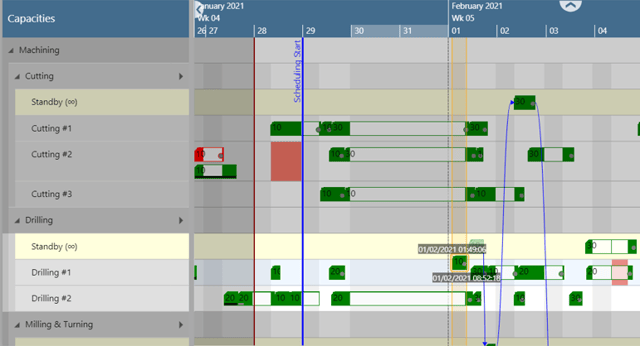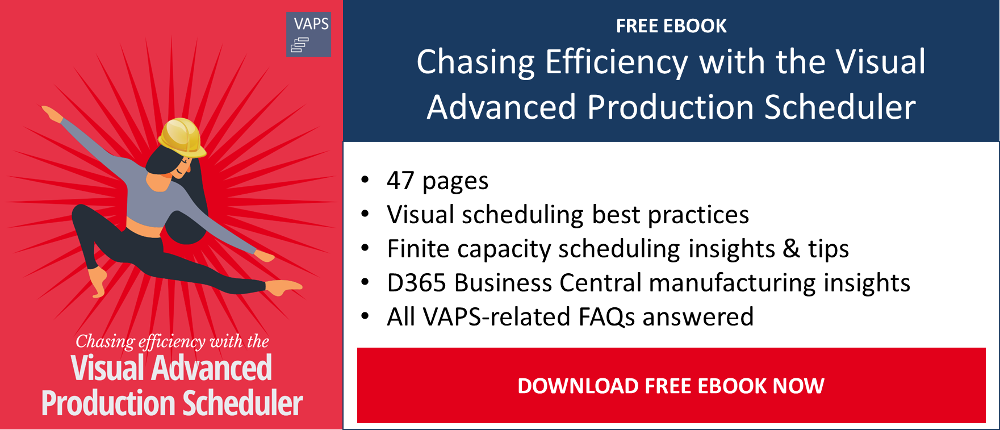Today we want to talk about scheduling, one of the words that NETRONIC aims to be synonymous with (besides visual 😊). First a little bit of history. NETRONIC brought its decades of expertise from creating Gantt chart software controls and translated this to creating visual scheduling add-ins for Microsoft Dynamics NAV.
When we started offering our first slew of products for NAV in back in the year 2013, we offered plain drag & drop scheduling. This feature allowed Dynamics NAV users to interact with their data via simple drag & drop actions on the Gantt Chart. Since then, our (production) scheduling options and capabilities have grown.
From the Visual Production Scheduler to the Visual Advanced Production Scheduler
The Visual Production Scheduler (VPS), Visual Job Scheduler (VJS) and Visual Service Scheduler (VSS) all used the drag & drop scheduling, which remains to be one of the most beloved features of our visual scheduling add-ins for Microsoft Dynamics NAV.

Although drag & drop scheduling was already a game changer, we noticed that a lot of companies had more complex requirements, that proved difficult for our add-ins at that time to handle.
If you have been following our blogs and social media, you may already have heard of the Visual Advanced Production Scheduler (VAPS), the newest member of our portfolio of products. It was built to solve the more complicated requirements of our manufacturing customers. It offers advanced interactive visual scheduling for production orders & capacities that is sure to enhance your experience on Business Central. With the VAPS we combine drag & drop scheduling with automatic finite capacity scheduling.
Since our launch in early 2020, we already trained more than 20 certified VAPS partners and are expecting to work with even more manufacturing-savvy partners in 2021.
The VAPS and the VPS have a lot in common but also have a lot of differences. One of their main differences is the fact that the VAPS is a finite capacity scheduler.
Hence, let us drill a bit into what makes up proper drag & drop scheduling and how finite capacity scheduling can enhance this in a compelling way.
Drag & drop scheduling
Drag & drop scheduling, a function that has been available in all our other products, is also available on the VAPS and can be applied to a schedule for the following instances:
- Scheduling your operations from the standby resource to one of your machine centers
- Reassigning your operations from one machine center to another
- Rescheduling an operation, changing its start and end date
Compared to our drag & drop scheduling on the VPS and VJS, on the VAPS is a bit different, given the fact that it works with finite capacity (see below).
If you would apply drag & drop scheduling on the VAPS the planner puts the utmost priority on that specific operation. When it is scheduled on a machine center, it moves out any other operations that were previously scheduled.
Dragging & dropping on the VAPS is done per operation, meaning that you cannot drag & drop the whole production order from the stand-by resource to the machine centers. To schedule your whole production order, you would need to use a combination of the VAPS scheduling instruments.
Drag & drop scheduling works hand in hand with the schedule successors functionality, as it also puts high priority on your production order. By using this feature, it allows you to schedule your production order, one operation after another, without any waiting time in between each operation. It moves out any other operations already scheduled.

Finite capacity scheduling
The VAPS comes with finite capacity scheduling, a functionality that a lot of manufacturers rely on in their day-to-day scheduling. This feature is something that standard Business Central offers via its capacity constraint resource functionality, but it does not really give planners the best experience. We decided to build upon the idea of offering a finite capacity scheduler, meaning that each machine center would have a capacity of one, therefore it would not be allowed to overload a machine center.
Finite capacity is the foundation of the VAPS. It allows us to make use of our alternate machine center custom table. Where the planner can establish alternate machine centers, ideally for machines that can produce the same output. The rate at which these machines can produce output can be configured based on the set-up time and run time.
Finite capacity also allows the planner to use our other scheduling instruments that is only available on the VAPS. Below is a quick summary of our various scheduling tools, but if you want to learn about them in more detail, then take a look at an earlier blog that we published (as of November 2020):

Working with the VAPS in an ideal way
Let’s say a rush order comes in and it requires a lot of attention. New production orders needs to be created on your planning worksheet, and you would want to schedule these on your VAPS:
- Create your production orders on your planning worksheet
- Color your priority production orders differently
- Make sure to use the progress view to use the required due date as your main KPI
- Schedule your production orders from the standby resource to your schedule
- Use one of your bulk scheduling tools
- Add-all
- Add-all including alternative machine centers
- After all your production orders are on the schedule you can use the fill idle time feature to further optimize your scheduler
- For any production orders that require special care, use the drag and drop functionality, to give it high priority and move out other operations already on the VAPS to make sure they can be completed before their respective required due dates. Use the schedule successor feature to make sure that there are no wait times between production order routing lines
Combining the different functionalities and types of scheduling that the VAPS has to offer, will most likely yield a better and more efficient plan.
Learn more about the VAPS
- Watch an introduction video about the VAPS
- Book a demo with us
- Get a free copy of our eBook


